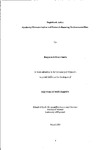Naphthenic Acids: Synthesis, Characterisation and Factors Influendng Environmental Fate
| dc.contributor.author | Smith, Benjamin Edward | |
| dc.contributor.other | Faculty of Science and Engineering | en_US |
| dc.date.accessioned | 2013-10-18T12:25:36Z | |
| dc.date.available | 2013-10-18T12:25:36Z | |
| dc.date.issued | 2006 | |
| dc.identifier | NOT AVAILABLE | en_US |
| dc.identifier.uri | http://hdl.handle.net/10026.1/2231 | |
| dc.description | Merged with duplicate record 10026.1/767 on 14.03.2017 by CS (TIS) | |
| dc.description.abstract |
The sustained high price of crude oil is increasing the viability of producing oils and tarry bitumens which have high acid contents and which would have been uneconomical to produce previously. The acidity of these oils is due to the presence of a class of compounds known as Naphthenic Acids (NAs) which are thought to arise from the biodegradation of some of the crude oil hydrocarbons. Some oils contain as much as 3% by weight NAs. The acids cause engineering and production difficulties through corrosion of refinery plant and deposition as salts in pipelines. NAs also cause environmental problems because they are known toxicants. For example, the processing of the vast tar sands deposits of Alberta, Canada results in tailings pond waters containing very high concentrations of NAs. The ponds are estimated to exceed a billion m³ by 2025 and are already visible from space. Bioremediation is an attractive option for reducing the toxicity of such NA wastes. However, an understanding of the biodegradation potential of NAs has previously been hindered by the lack of knowledge of the molecular structure of individual NAs and by the lack of appropriate suitable surrogate acids for detailed mechanistic studies. Although it is known that NAs are complex mixtures of alkyl substituted, mainly alicyclic, carboxylic acids fitting the general formula CaH2n-zO2, where Z denotes the hydrogen deficiency resulting from ring formation, beyond this, comparatively little was known of NA chemistry, prior to the present study. The current study describes the synthesis of a series of novel monocyclic surrogate NAs containing both alkyl and alkanoate side-chains (viz: butylcyclohexylbutanoic acids, BCHBAs). The branching in the butyl chain was varied in a systematic way from n-through sec-, iso- and tert-butyl. The surrogates were synthesised in high purity (>94%) and rigorously characterised at each synthetic stage by various spectroscopic techniques. A toxicity assay in which developing oyster (Crassostrea gigas) embryos were inoculated with the individual monocyclic surrogate NAs demonstrated EC50 (Effective Concentrations for 50% of population) values ranging from 0.11 mg Lˉ¹ to 0.49 mg Lˉ¹. The results exhibited a clear quantitative structure-activity relationship (QSAR) between the degree of branching in the alkyl chain and the toxic effect, with the less branched NAs exhibiting the highest toxicity. A detailed biodegradation study of the monocyclic surrogate NAs was made. Again a clear QSAR was established. In this instance, n-BCHBA was the most readily degraded with 97% degradation by day 9, and tert-BCHBA the most resistant with only 2% degradation by day 30, whereas iso-BCHBA and sec-BCHBA were 77% and 53% degraded after 30 days, respectively. The degradation of the monocyclic surrogate NAs proceeded with the production of major metabolites consistent with β-oxidation of the alkanoic acid side chain. The metabolites were tentatively identified by mass spectrometry as the ethanoic acid analogues of the butanoic acids. These resisted further biodegradation. That biodegradation proceeded via β-oxidation was confirmed by the synthesis and subsequent biodegradation additional methyl branch in the butanoic acid side chain effectively halted biodegradation. The QSAR observed in the toxicity and biodegradation experiments is thought to be related to the hydrophobicity of the individual NA surrogates, which determines their bioavailability. These results with surrogate compounds help to explain previous reports of the biodegradation of natural NAs in which reductions in toxicity during initial biodegradation have been observed. The surrogate NAs synthesised herein were also used to devise a unique derivatisation procedure which then facilitated the analysis of synthetic and natural NAs by liquid chromatography-multistage mass spectrometry (LC-MS"). Analysis of the resulting naphthenic amides (NAds) allowed an improvement in detection of over two orders in magnitude by positive ion electrospray ionisation-mass spectrometry (ESI-MS) compared to negative ion ESI-MS. The improved response allowed multistage LC-ESI-MS" experiments to be carried out and detailed mass spectral fragmentation pathways for individual NAds to be deduced. Analysis of derivatised natural NA mixtures then allowed a more detailed molecular characterisation of individual NAs than has been possible hitherto. The use of the surrogate NAs synthesised herein has thus improved significantly our understanding of NA chemistry and the influence of NA structure on the potential for NA bioremediation. | en_US |
| dc.language.iso | en | en_US |
| dc.publisher | University of Plymouth | en_US |
| dc.title | Naphthenic Acids: Synthesis, Characterisation and Factors Influendng Environmental Fate | en_US |
| dc.type | Thesis | |
| dc.identifier.doi | http://dx.doi.org/10.24382/4532 |
Files in this item
This item appears in the following Collection(s)
-
01 Research Theses Main Collection
Research Theses Main


